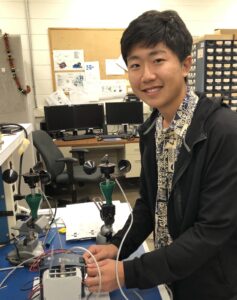
Matthew Fujioka is from Oahu, where he graduated from President Theodore Roosevelt High School in 2022. He is in his first year at the University of Hawaii at Manoa, majoring in a Bachelor of Science in Mechanical Engineering. Matthew is currently the financial officer of the UH Drone Technologies Lab, a member of the Native Hawaiian Science Engineering Mentorship Program, and a member of the Manoa Scholar’s Club. In his free time, Matthew enjoys playing tennis and participating in programs to help teach young students about engineering concepts. Matthew hopes to expand his knowledge and experience in mechanical engineering and its impactful applications.
Home Island: Oahu
High School: President Theodore Roosevelt High School
Institution when accepted: University of Hawaii at Manoa
An Analysis of Energy Usage and Reduction Strategies for Selected Keck Observatory Facilities
Project Site: M. Keck Observatory, Waimea, HI
Mentors: Craig Nance & Kevin Tsubota
Project Abstract:
The W. M. Keck Observatory (WMKO) aspires to be a leader in green energy initiatives in the astronomical community. WMKO’s carbon emissions are divided into three categories: Scope 1 are direct carbon emissions, Scope 2 are indirect carbon emissions focused on electricity consumption, and Scope 3 are indirect carbon emissions focused on air travel. This project studied Scope 2, beginning with the summit facility’s electricity usage, which equates to $1M and 1600 tons of carbon dioxide equivalent (tCO2e) annually. Through analysis of 3 years of Hawaii Electric Light Co. (HELCO) billing and other data, a report was compiled and provided to observatory leadership, concluding that recent cost increases are due to the escalating price per kilowatt-hour (kWh) rather than greater usage. The report modeled HELCO’s plan to put all customers, including WMKO, on a Time of Use (ToU) schedule that would charge an increased rate at night when the facility consumes the greatest amount of electricity. The analysis concludes that electrical costs will only increase by 10%. This report led to a change in strategy to focus purely on energy reductions and not load shifting. We identified the observatory dome exhaust fans as an ideal candidate for energy reduction: the fans are the largest single loads at the observatory, rated at 100 hp. Our report recommends running the fans less often, as opposed to upgrading with more energy-efficient motors. To fully understand the use of the fans, anemometers were installed in the exhaust wind tunnels to measure the flow rate. In addition, the performance of the photovoltaic system was analyzed to determine the return-on-investment and percentage of savings.